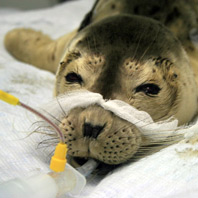TV Program Description
Original PBS Broadcast Date: November 25, 2008
Part emergency room, part rehab facility, and part research
lab, the Marine Mammal Center in Sausalito, California means
the difference between life and death for sick and injured
ocean animals. NOVA takes you inside this very special ER to
witness the efforts of a renowned team of wildlife
veterinarians as they fight to save their animal patients as
well as to uncover the cause of a mysterious neurological
illness plaguing marine mammals like California sea lions and
harbor seal pups.
Not only are these animal patients endearing, they are also
sending us an urgent message about the health of our oceans.
[Doug Hamilton, who spent months behind the scenes at the
Marine Mammal Center, explains more in his
Producer's Story.]
Veterinarians Frances Gulland and Felicia Nutter direct
medical treatment at the center. In the late 1990s, Gulland
first suspected a link between wrenching neurological symptoms
afflicting marine mammals and domoic acid, a neurotoxin
produced by algal blooms. Now, Gulland and Nutter work with a
team of passionate volunteers to rescue sick and dying animals
languishing on beaches. All too many of the animals are
victims of the deadly domoic acid poisoning; others are
malnourished pups separated from their mothers; and some bear
deep scars that are the result of being entangled in plastic
trash floating in our oceans.
Veterinarians at the center treat animals using a combination
of traditional hands-on care and cutting-edge technology. The
goal is to rehabilitate each animal and release it back into
the wild.
According to Paula Apsell, NOVA's senior executive producer,
the program is much more than the story of these compassionate
caretakers. "This documentary focuses on our changing
environment as well as the innovative techniques pioneered at
the Marine Mammal Center that are saving aquatic animals
around the world."
NOVA travels to Oahu with Dr. Gulland as she applies practices
developed at the center to save an endangered Hawaiian monk
seal, a species on the brink of extinction. Says producer
Hamilton, "With an estimated 1,200 Hawaiian monk seals
remaining in the world, the survival of every individual is
vital."
Dan Costa, a biologist from the University of California,
Santa Cruz, is among the researchers featured in the film. He
studies healthy elephant seals in the wild using satellite
tags, which are glued to the elephant seals' heads like
"electronic yarmulkes," as Costa puts it. Costa's satellite
tracking has revealed an extraordinary migration that was
previously hidden underwater: Some animals have been shown to
make a roundtrip beyond the international dateline, a distance
nearly twice the width of the United States. They do it alone
every year, and most return to the exact same beach. Dr.
Nutter marvels at the elephant seals' annual migration route,
"It's like the Serengeti of the sea, but nobody sees it."
The experts interviewed in the film believe that many of the
maladies plaguing marine mammals reflect the declining health
of our oceans and the profound effect that humans have on the
environment. Hamilton describes the nearly 1,000 animals
treated each year at the Marine Mammal Center as "canaries in
a coal mine." He adds, "We wanted to show the links between
human behavior, the deteriorating health of marine mammals,
and the destruction of their habitat."
Program Transcript
Program Credits

